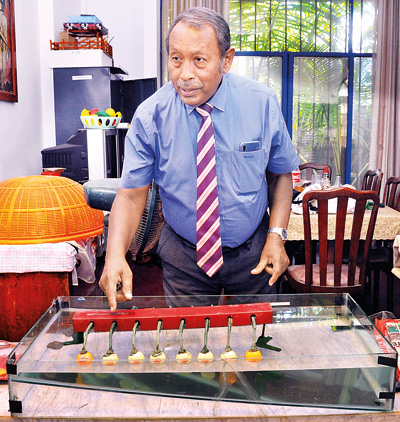Sea energy idea ignored by Governments since ’80s

Mr. Duncan Wickramasinghe shows a prototype of his sea energy model. Pic by Priyantha Wickramarachchi.
The current power crisis could have been averted if politicians had implemented a cheap and cost-effective method to harness wave power from the seas surrounding the island, according to hotelier-turned-inventor Duncan Wickramasinghe.
Mr. Wickramasinghe, in an interview with the Business Times on Friday, charged successive governments with turning a blind eye to proposals brought by him over the years to turn sea energy into electricity – his first proposal being made in 1979 when Sri Lanka suffered its first power cuts.
“At the time, I made an initial proposal after being struck by the fact that even massive ships bob up-and-down on the sea because of waves. If a 100,000 tonne ship could be lifted by waves, I realised even back then how much of energy there must be in the sea,” Mr. Wickramasinghe harked back.
“But a proposal I made to a number of governments – from both parties, the Rajapaksas as well as the UNP – fell on deaf ears. I even approached Arthur C. Clarke with my idea but nothing came out of that too,” related Mr. Wickramasinghe.
His idea, put simply, was to build a structure comprising of movable arms attached to a wheel which in turn would be connected to a dynamo. When the waves hit the movable arms it would move up-and down turning the wheel and generating energy.
“The up-and down movement creates mechanical energy which can be turned into a source of power which is not only eco-friendly but totally renewable and sustainable.
“I approached the people in power on many occasions. I wrote letters to then Minister of Power and Energy, Karu Jayasuriya but did not get any response. A few years later I wrote to the Rajapaksas, Mahinda and Gotabaya, and even met Lalith Weeratunga, but again got no response.
“They all said to wait. I’m still waiting. If these Governments had taken action back then, the people of this country would not have to undergo the hardships they are facing today due to the power cuts,” declared Mr. Wickramasinghe.
He was struck with his brainwave back in 1979, when as a former employee of the Hotel InterContinental, Mr. Wickramasinghe was present one day when the late Lalith Athulathmudali had arrived for a press conference at the hotel.
“We had to keep the doors of the hall open as it was so hot. The hall overlooked the sea and it was then I was struck by this idea watching a ship move up-and-down due to the wave movement.
“Many countries already use marine power generated by waves. Around 12 per cent of the electricity generated by the national grid in Spain comes from the sea. In Portugal it is about 13 per cent and Ireland 11 per cent. Even India is harnessing power from the sea. Why can’t Sri Lanka, an island nation follow suit,” asks Mr. WickramasingHe.
The lights go out in his home at Mattakkuliya as he answers the same question with his next breath.
“It is because our politicians have vested interests. There is money to be made from using coal and hydropower to generate electricity. Even in the West, the large oil industry and coal industry plays a huge role in clamping down on the development of wave energy.”
Mr. Wickramasinghe said he could solve the current power crisis within three months and challenged the current Government to prove they have the needs of the community at heart.
“All I need is one million rupees held by a trustee, and a small team of people. I need one electrical engineer, a civil engineer, a mechanical engineer, a couple of welders, masons and carpenters and I will build a plant capable of generating 50 KWH to the national grid.”
Sri Lanka is fortunate in having seas suitable for generating maximum power, according to Mr. Wickramasinghe.
“We are surrounded by a ‘golu muhuda’ or dumb sea. Unlike in other parts of the world, our seas are not rough and we have six waves per minute. Every wave generates 50 horsepower. If we have a buoy with eight arms, that translates into 400HP. If we build a float with 20 buoys, that will mean 8,000HP. And this is per wave. You multiply this by six – six waves per minute – and you get 48,000HP per minute or 800 HP per second. This is enough to run a 300MV generator,” he explained.
Sri Lanka’s annual consumption of electricity is 12.67 million KWH, something which could be provided easily from wave power, says Mr. Wickramasinghe.
“We need people with vision to implement a solution which will provide electricity round the clock irrespective of outside conditions like drought. If we implement this solution it will also be a barrier to sea erosion and enhance marine life around our shores.
“I first came up with this idea in 1979. Over the last 40 years I have been studying this and refining my idea. I’m still waiting for the government of the day to take it up and implement it. If it is done, we will not have to suffer power cuts anymore,” Mr. Wickramasinge added.


